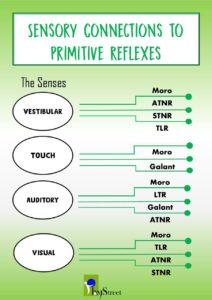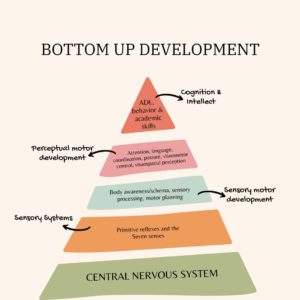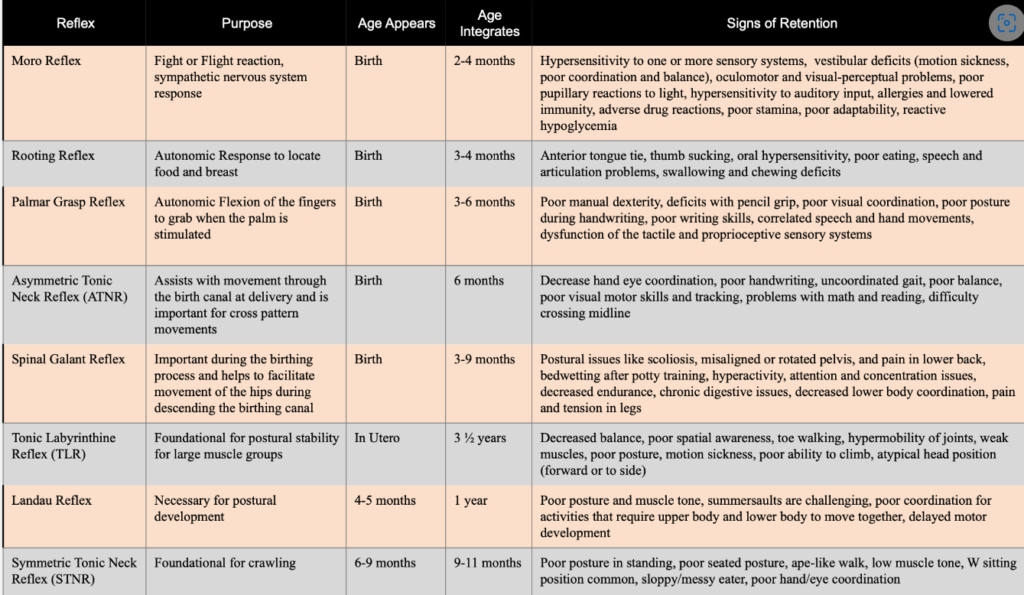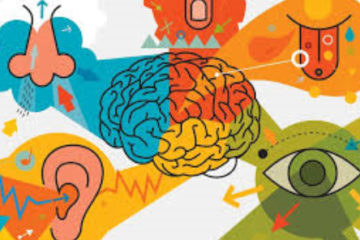Primitive reflexes are natural, automatic movements in infants and young children. These reflexes are necessary for survival and development in the early stages of life. However, in typically developing children, these reflexes gradually disappear as the child develops more mature voluntary movements. Each reflex is associated with the sensory processing systems and the body’s motor systems. If retained or unintegrated, a child may experience dysfunction within one or several sensory processing systems, leading to sensory processing disorder and various motor difficulties.

In some children with ASD and other neurodevelopmental delays, these reflexes persist beyond the expected age of disappearance, around 12-18 months. This condition is called retained primitive reflexes. They are common in children with ASD and can interfere with their motor development, coordination, balance, and posture. This, in turn, can affect their ability to learn, socialize, and communicate, as shown below in the picture.
 Studies have shown that children with ASD are more likely to have retained primitive reflexes than typically developing children. It is estimated that up to 80% of children with ASD have at least one retained primitive reflex.
Studies have shown that children with ASD are more likely to have retained primitive reflexes than typically developing children. It is estimated that up to 80% of children with ASD have at least one retained primitive reflex.
The exact cause of retained primitive reflexes in children with ASD is not fully understood. Some researchers believe that it could be due to neurological differences in the brain, while others suggest that it could be due to delays in the development of the nervous system.
Types of Primitive Reflexes
Some of the most common ones that are retained in children with ASD and neurodevelopmental delays include the following:
Moro reflex: It is also known as the startle reflex. The Moro reflex is an involuntary startle response that occurs when a baby is startled. It is essential for the development of balance and coordination. In children with autism and other neurodevelopmental delays, this reflex may be exaggerated or prolonged, leading to issues with balance and coordination.
Asymmetrical tonic neck reflex (ATNR): The ATNR reflex is an involuntary response when a baby’s head is turned to one side. It is essential for the development of head control and balance. In children with autism and other neurodevelopmental delays, this reflex may be exaggerated or prolonged, leading to head control and balance issues.
Symmetrical tonic neck reflex (STNR): The Symmetric Tonic Neck Reflex (STNR) is essential in children as it is associated with inattention and executive function deficits. Studies have shown that children with ADHD and Autism have significantly higher reactions to the STNR reflex.
Palmar grasp reflex: The Palmar Grasp reflex is an involuntary response when touching a baby’s palm. It is vital for the development of fine motor skills. In children with autism and other neurodevelopmental delays, this reflex may be exaggerated or prolonged, leading to issues with fine motor skills.
Babinski reflex: The Babinski reflex is vital in the early stages of a child’s development as it indicates the proper functioning of the neurological pathways that control movement. Retainment of this reflex can cause various issues, including poor muscle tone, fatigue, vestibular-related problems, free-floating anxiety, mood swings, and difficulty focusing and controlling impulses.
Tonic Labyrinthine Reflex: The TLR is a primitive reflex that is important for developing balance and coordination. When the reflex is retained, it can lead to issues with motor skills, coordination, and balance, and sensory processing issues. Children with autism are more likely to have retained TLR than typically developing children because the brain of a child with autism may not be able to process the information needed to suppress the reflex.
Rooting reflex: The Rooting reflex is an involuntary response when touching a baby’s cheek. It is essential for the development of feeding skills. In children with autism and other neurodevelopmental delays, this reflex may be exaggerated or prolonged, leading to issues with feeding.
Spinal Galant reflex: The Spinal Galant reflex is elicited by stroking or tapping the lower back, which causes a contraction of the muscles in the lower back and hip area. Retained Spinal Galant reflex has been associated with motor and sensory difficulties and behavioral issues such as hyperactivity, poor concentration, and poor impulse control.
Effects of Retained Primitive Reflexes on Autistic Children
Retained primitive reflexes can have several adverse effects on the development of children with autism and other neurodevelopmental delays. These reflexes can interfere with a child’s ability to coordinate their movements and maintain balance, affecting their ability to learn new skills, interact with others, and perform daily activities. The following table describes the impact of retained reflexes on children with autism and other neurodevelopmental delays.

Treatment for Retained Primitive Reflexes
Several treatment options exist for retained primitive reflexes in children with autism and other neurodevelopmental delays. The interventional approaches include:
Masgutova Neurosensorimotor Reflex Integration (MNRI) is a holistic approach to addressing neurological challenges related to primitive reflexes. It incorporates various techniques, including reflex stimulation, rhythmic movement, craniosacral therapy, and sensory integration. These techniques activate specific reflexes and sensory pathways and help the individual integrate these pathways into more complex activities and behaviors.
Rhythmic Movement Training (RMT) is a movement-based therapy that can help with primitive reflex integration. RMT uses specific movements and exercises to activate the brainstem and midbrain, which are involved in primitive reflexes and other foundational movements. It helps integrate primitive reflexes by activating the brainstem and midbrain and promoting cross-midline movements and primitive reflex stimulation. It is often used with other therapies, such as MNRI, to provide a comprehensive approach to primitive reflex integration.
Movement-based learning (MBL) is an effective intervention for retaining primitive reflexes in children with autism. It involves specific exercises and activities that target the integration of primitive reflexes through movement and sensory experiences. It is important to note that movement-based learning interventions should be individualized to meet the needs of each child.
Occupational therapy focuses on improving a child’s fine motor skills, coordination, and balance, improving the higher skills of ADL, school, and play. Occupational therapists are trained to assess and treat motor and sensory issues that affect a child’s ability to perform daily activities due to retained primitive reflexes. They can provide a range of interventions through purposeful activities to help improve motor skills, sensory processing, and overall functional abilities.
Physical therapy focuses on providing exercises and activities that help improve motor skills, coordination, balance, and posture.
Speech therapy is an effective intervention for reflex integration in children with autism. Speech therapists provide a range of interventions that address oral motor skills, sensory processing, social communication, and AAC, which help children improve their speech and language development and overall ability to process and integrate sensory information.
Brain Gym is a series of exercises that promote the integration of primitive reflexes through movement-based activities. These exercises activate specific brain regions and neural pathways to help the child develop more efficient movement patterns.
In conclusion, retained primitive reflexes are common in children with autism and other neurodevelopmental delays. These reflexes can interfere with a child’s motor development, coordination, balance, and posture. However, with early detection and appropriate treatment, many children with retained primitive reflexes can improve their motor skills and overall development.
References
-
- Primitive Reflex Integration – Playstreet
- https://uncoverautism.com/autism-and-retained-primitive-reflexes/
- https://epidemicanswers.org/importance-retained-reflexes-in-developmental-delays/
- https://www.theottoolbox.com/retained-primitive-reflexes-child-development/
- https://pubmed.ncbi.nlm.nih.go
- https://link.springer.com/article/10.1007/s40474-021-00232-2
- https://www.moveplaythrive.com



0 Comments